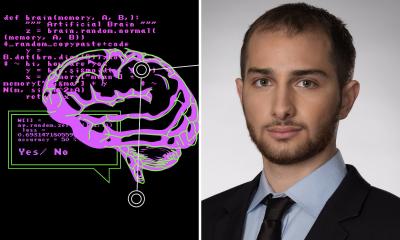`Moleculary´ medicine: now and the future
In an interview with Daniela Zimmermann, Executive Director of European Hospital, Dr Mohammad Naraghi, Head of the Department of Business Development at Siemens Medical Solutions, discussed developments in moleculary medicine, biochips, preventive diagnostics and a comprehensive and integrated health system for the future.

The term moleculary medicine is increasingly heard. In diagnostics, Dr Naraghi explained that this means the knowledge of moleculary causes for the development of diseases is used to prevent, or diagnose and treat those diseases at an early stage, which can be done with the help of laboratory diagnostics as well as imaging diagnostic procedures, adding: ‘Molecular imaging plays a very strategic role.’
Data mining is another increasingly used term. ‘In the field of moleculary diagnostics data mining initially means the analysis of large amounts of data with the help of information technology and to look, for example, for genetic or other, clinical patterns that can signal potential disease,’ he explained. ‘To do this we need a highly efficient IT infrastructure. Modern medical diagnosis procedures, such as CT, MRI or, in the future, moleculary methods, produce rapidly increasing amounts of data. The challenge is to analyse these intelligently and in an integrated manner so that we can extract clinically relevant, action-oriented information from them. However, this assumes that we can overcome today’s clinical data silos and establish integrated, electronic patient files, ideally across current boundaries of care.
‘To recognise and visualise diseased processes through molecular interaction, molecular imaging needs molecular contrast media and radiopharmaceuticals.’
Two distinctions are made for disease diagnoses: in the first a patient already has a disease, in the other the patient is described as being predisposed to a disease, for example developing breast cancer. ‘A predisposition shows the likelihood of developing a disease, which can have genetic causes. Certain combinations of genes, for example, have a very high likelihood of resulting in cancer or other diseases. If a patient has a certain combination of genes, which, in many other patients, has been confirmed as a trigger for a certain illness, he has a very high predisposition. The other subject is the diagnosis of a disease that is already established, with the help of molecular-medical methods - and to do this earlier than currently done. In addition, gene-technological methods will also be used for the recognition of predispositions. In some cases we can definitely determine that a disease has genetic causes, for example cystic fibrosis and other diseases, such as Huntington’s.
In predisposition, the professor pointed out that one of the big challenges is to determine in what ways a patient is likely to develop a disease, whether or not it progresses and over what period of time. ‘At the moment there are no recorded procedures for this. What we can say is that, if a predisposition exists, a disease is likely to develop over a certain period of time with a certain statistic probability. However, we must take into account that all diseases are different, and won’t necessarily develop. From a purely statistic point of view we can determine the average probability of the disease developing. For instance, the probability for a woman to develop breast cancer at some stage in her life is x percent. Then we can say that if a woman has specific genes in a modified form often known to trigger cancer then the probability of her developing the disease at some point in her life is not x percent but possibly 3x or 5x percent. However, once you have established that someone has a higher probability of developing this or that disease you can screen and monitor so that, if the diseases actually develops, we can start therapy at a very early stage.’
In the case of breast cancer, for example, although this scenario could be quite comforting for statisticians, wouldn’t it scare women in terms of its predictability and then at what stage in life it would occur? Dr Naraghi concurred, but pointed out: ‘Thanks to moleculary diagnostics we will have very efficient methods at our disposal in the future to recognise the occurrence and progress of diseases. Depending on their predispositions, doctors are able to recommend that patients be screened and monitored on a regular basis. If the disease then actually develops, the diagnosis can be made at a very early stage and therapy will be much more successful if commenced early. Surely this brings us one step further!’
This could also mean a significant cost-saving potential from a commercial point of view. ‘The largest block of costs arising in the healthcare system today develops because many diseases are diagnosed too late, and then the system has to bear the costs of coping with the long-term consequences,’ he replied. ‘Let’s look at oncological, neurological and degenerative diseases and, for example, the fact that a high percentage of colon cancer cases can be diagnosed and it can be removed at an early stage with the help of endoscopy and other methods. Molecular diagnosis will enable us to recognise these diseases at an even earlier stage of their development. And this will, again, save costs and dealing with the long-term effects of these illnesses. We are hoping, for instance, to diagnose Alzheimer’s at an early stage before the whole range of clinical symptoms manifests itself. And if we then also have medication available, which at least slows down the process of the illness, we would enhance a patient’s quality of life a lot. It would also have enormous economic effects because, for instance, we could save on costs for long-term care.
Returning to the discussion on contrast media, used in combination with different imaging diagnostic procedures such as PET, SPECT, MRI, we asked which procedure is used in which cases? ‘It very much depends on the disease. PET-CT is often used in the case of oncological diseases. MRI is the preferred method for neurological problems, and we use CT and SPECT for cardiac problems. There are many differences, and we have long-term clinical experience of which methods should be used in which case.’
However, Dr Naraghi pointed out that truly molecular contrast media is as yet unavailable. ‘They are at the early stage of development. So we cannot yet say what the consequences will be in every single case. But it is likely that innovations in the area of contrast media and progress in the area of molecular medicine in general will change and enhance the use of different methods of imaging diagnosis.’
Contrast media generate a new connection between medicine technology and the pharmaceuticals industry. To highlight this, we referred to the GE acquisition of Amersham, and asked about Siemens’ views on potential opportunities. ‘Our strategy is to offer solutions that help our customers to improve the quality of care and to lower costs - to increase efficiency through innovations and process optimisation When putting these strategies into practice we not only think about single segments of the healthcare system but about its entirety. We talk about integrated solutions, which comprise all areas - prevention, diagnosis, therapy and care. Based on this background we continually work out how these objectives can be realised. Where necessary we will enter into the appropriate co-operations and partnerships. In the area of molecular medicine, and contrast media in particular, we think that many innovations will not come from one single company but from a whole range of innovative companies, larger and smaller institutions, research facilities and hospitals. This means that we are more likely to be thinking about partnerships and co-operations in this area.
When did he think the first, truly molecular contrast medium might become available? ‘This is difficult to say,’ he replied. ‘It will take a few years and will also depend on the readiness of the regulating bodies in the US, Europe and elsewhere to facilitate faster licensing procedures.
07.08.2006










